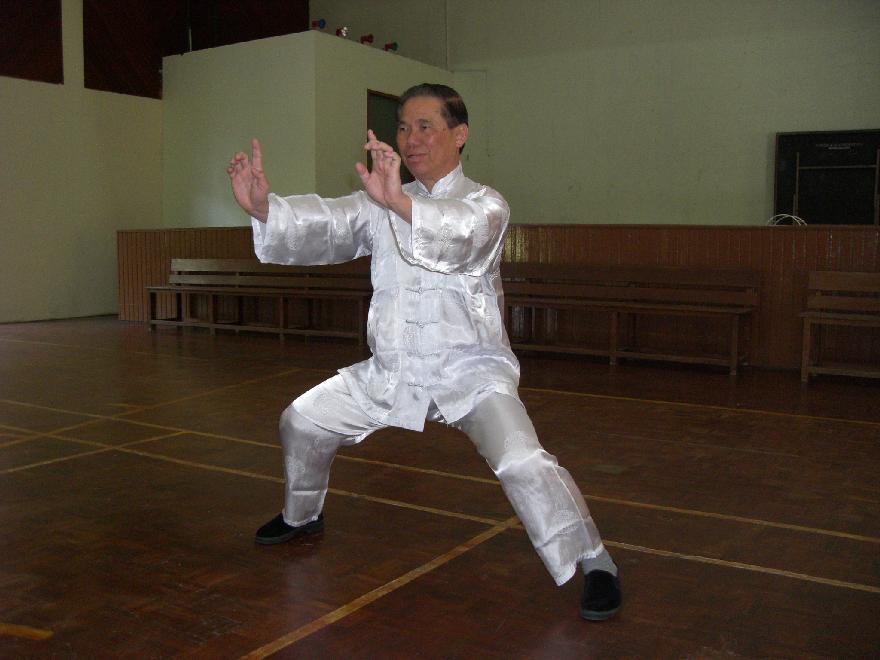INTERNAL-EXTERNAL DOUBLE CULTIVATION

Practice Golden Bridge is internal cultivation
Question 6
My experience with building internal force has clearly demonstrated the fact that internal force has benefited my physical/external body -- health, endurance, strength. I have also noticed that when I maintain a moderate level of external stimulus (physical labor/construction job, cycling, rock climbing, heavy yard work like moving rocks, etc), there seems to be a cross over benefit to my internal training (i.e. stance training is more relaxed and at a deeper level, condensing force feels more powerful, etc). I have experienced the opposite to also be true, and if my lifestyle is too sedentary, it seems to have a negative impact on my internal training.
Is there a link between external stimulus and building internal force? Typically, Water Buffalo methods are used to build external strength, but can they also be used as an adjunct to internal force training, for even more benefit?
Sifu Matt Fenton
Answer
Internal force certainly benefits the physical or external body. If all other things were equal, internal force contributes more to health, endurance and strength than external strength. Indeed, some forms of external training, like lifting weights and jabbing palms into iron filing, can be detrimental to health, although they may contribute to strength and endurance.
On the other hand, a moderate level of external stimulus, like physical labor and moving rocks, can enhance internal training, provided that the external stimulus is not overdone. This benefit leads to the recommendation known in Chinese (Cantonese) as “noi ngoi seong sau”, or “internal-external double cultivation”.
Great kungfu masters in the past were known for their internal-external double cultivation, never just cultivated internally. However, their external cultivation did not refer to such external methods like lifting weights, jabbing palms into iron filing, hitting sand-bags and striking wooden-man, which were regarded as third-class methods, but referred to methods like performing kungfu sequences or sets, Children’s Art, Thousand Steps and Art of Flexibility.
If a master, for example, performed only Abdominal Breathing, which was considered internal cultivation, but neglected the practice of his kungfu sets, which was considered external cultivation, he would not be very advanced. He might have a lot of internal force from his Abdominal Breathing, but lacked agility which could be derived from set-practice.
If a person’s lifestyle is too sedentary, he would not be healthy. The great Chinese physician, Hua Tuo, described this condition as “a door not in use would soon rot”.
Yes, there is a link between external stimulus and building internal force. They contribute to yin-yang harmony.
Water buffalo methods, when used judiciously, can be used as an adjunct to internal force training. For example, after practicing Golden Bridge for some time, which develops internal force, a practitioner may place a staff over his extended arms, hanging some light weights at both ends of the staff. The added weight will enhance his training, enabling him to achieve more internal force in a shorter time.
Strictly speaking, this is not water buffalo training; it is smart training. If the practitioner started with the staff and weights at the beginning, and tensed the muscles of his arms to support the weights, he could develop external strength and endurance, but it would be water buffalo training. He would develop more internal force, compared to his external strength, and in a shorter time, had he not used the weights at all.
Similarly, those who have developed internal force using the Iron Wire Set, may wear copper rings in their forearms to enhance their training. But had they used copper rings at the start and performed Iron Wire with muscular strength, it would become water buffalo training. They would have big muscles and be powerful with external strength, but it was not internal force.
I myself underwent water buffalo training, like practicing Iron Palm, hitting wooden-man and jabbing my hands into beans. But I found internal cultivation far superior. It produced a lot more force. Not only my internal force enabled me to break bricks (instead of opponents’ bones) and take punches and kicks without sustaining injury, but more significantly it contributed to my health, vitality and longevity, and daily peak performance.

Practicing a kungfu set like Four Gates is external cultivation
The questions and answers are reproduced from the thread Secrets of Building Internal Force in the Shaolin Wahnam Discussion Forum.
LINKS
